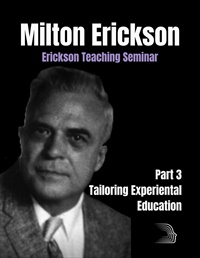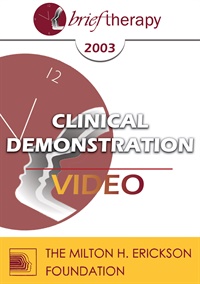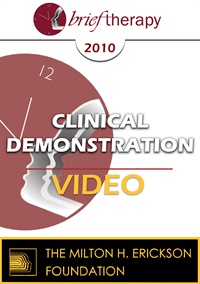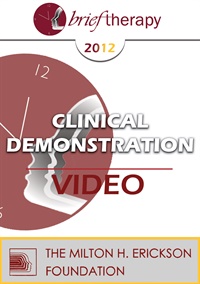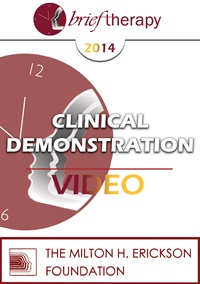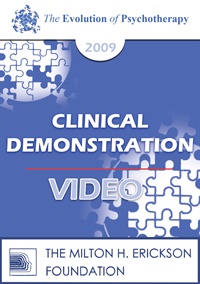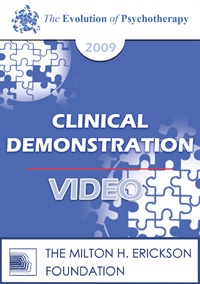Credit available - Click Here for more information
- Average Rating:
- Not yet rated
- Topic Areas:
- Tailoring | Ericksonian Hypnosis and Therapy Techniques | Experiential Therapy | Milton Erickson | Trance | Unconscious Processes
- Categories:
- Erickson Materials | Erickson Streaming Video Collection | Milton H. Erickson Collections
- Faculty:
- Milton H. Erickson, MD | Jeffrey Zeig, PhD
- Course Levels:
- Master Degree or Higher in Health-Related Field
- Duration:
- 1 hour
- Format:
- Audio and Video
- Original Program Date:
- May 07, 2020
- Short Description:
- In part three of a Teaching Seminar with Milton Erickson, we continue the development of trance experience in the primary subject. You will encounter the experiential teaching method for which Erickson was renowned.
- Price:
- $29.95 - Base Price
- Average Rating:
- Not yet rated
- Topic Areas:
- Clinical Demonstrations | Pain and Healing | Brief Therapy | Hypnosis | Trance
- Categories:
- Brief Therapy Conference | Brief Therapy Conference 2003
- Faculty:
- Stephen Lankton, MSW
- Course Levels:
- Master Degree or Higher in Health-Related Field
- Duration:
- 59:27
- Format:
- Audio and Video
- Original Program Date:
- Dec 12, 2003
- Short Description:
- Educational Objectives: 1) To describe the use of three trance phenomena in the reduction of pain. 2) To describe how hypnosis for pain control can be introduced in brief therapy.
- Price:
-
Sale is $29.00
price reduced from Base Price - $59.00
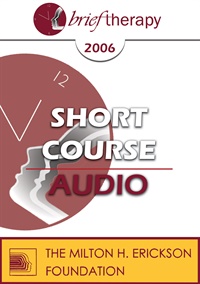
- Average Rating:
- Not yet rated
- Topic Areas:
- Short Courses | Trance | Burnout | Humor | Brief Therapy
- Categories:
- Brief Therapy Conference | Brief Therapy Conference 2006
- Faculty:
- Betty Blue, PhD
- Duration:
- 1:11:24
- Format:
- Audio Only
- Original Program Date:
- Dec 07, 2006
- Short Description:
- This short course will use theory, techniques and group experience to demonstrate how playful self-expression, humor and self-soothing indulgent fantasy can be used in and outside the therapeutic setting to produce spiritually uplifting trance states. We will learn how to discourage "learned helplessness" and "burn out", encourage the ability to cope with life's challenges and increase opportunities to enhance the body's natural immune system functioning.
- Price:
- $15.00 - Base Price
Tags: Burnout Humor Trance Brief Therapy
- Average Rating:
- Not yet rated
- Topic Areas:
- Fundamentals of Hypnosis | Hypnosis | Phenomenology | Hypnotic Induction | Trance | Tailoring
- Categories:
- Brief Therapy Conference | Brief Therapy Conference 2008
- Faculty:
- Jeffrey Zeig, PhD
- Course Levels:
- Master Degree or Higher in Health-Related Field
- Duration:
- 2:23:04
- Format:
- Audio and Video
- Original Program Date:
- Dec 11, 2008
- Short Description:
- Hypnosis is not a thing, but a way that things happen. To make hypnosis happen a clinician needs to understand the underlying architecture of trance. Eliciting systemic components elicits trance. The grammar, context and relational elements of eliciting these components will be explained. We will develop an induction model based on three steps. This workshop will consist of lecture, demonstration and small group practice.
- Price:
- $29.00 - Base Price
- Average Rating:
- Not yet rated
- Topic Areas:
- Fundamentals of Hypnosis | Hypnosis | Hypnotic Induction | Resources | Trance
- Categories:
- Brief Therapy Conference | Brief Therapy Conference 2008
- Faculty:
- Stephen Gilligan, PhD
- Course Levels:
- Master Degree or Higher in Health-Related Field
- Duration:
- 2:26:46
- Format:
- Audio and Video
- Original Program Date:
- Dec 12, 2008
- Short Description:
- This session explores various methods for eliciting hypnotic trance in a therapy situation. The relevance of utilizing key aspects of a client's resources and symptoms, as well as different ways to gage and incorporate ongoing feedback will be emphasized.
- Price:
- $29.00 - Base Price
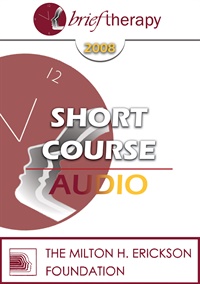
- Average Rating:
- Not yet rated
- Topic Areas:
- Short Courses | Addiction | Hypnosis | Trance | Trauma | Brief Therapy | Dissociation
- Categories:
- Brief Therapy Conference | Brief Therapy Conference 2008
- Faculty:
- Albina Tamalonis, PsyD
- Duration:
- 1:31:45
- Format:
- Audio Only
- Original Program Date:
- Dec 11, 2008
- Short Description:
- People who are traumatized, and/or have one of the multitudes of addictive disorders are, in great part, dissociated from their physical reality. There is research which indicates that people who exercise are more likely to suffer from less anxiety, pain and depression. This short course offers a practical approach to overcoming people's reluctance to exercise by using active-alert hypnosis and music. By listening to hypnosis with music while exercising, people can alter their perceptions of pain, time, effort and pleasure. The words of the hypnosis are taken from the works of Milton H. Erickson, Jeffrey Zeig, Michael Yapko and Eva Banyai. Their different contributions will be delineated and explained.
- Price:
- $15.00 - Base Price
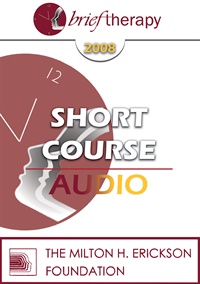
- Average Rating:
- Not yet rated
- Topic Areas:
- Short Courses | Metaphors | Trance | Brief Therapy | Communication
- Categories:
- Brief Therapy Conference | Brief Therapy Conference 2008
- Faculty:
- Betty Blue, PhD
- Duration:
- 1:10:52
- Format:
- Audio Only
- Original Program Date:
- Dec 11, 2008
- Short Description:
- This course will use theory, clinical examples, techniques, PowerPoint illustrations, quotations and experiential metaphorical fantasy to display how compassionately playful client-therapist interactions can serve to encourage transcendence from suffering, solution expansion and professionally appropriate intimacy while also discouraging states of maladaptive isolation.
- Price:
- $15.00 - Base Price
- Average Rating:
- Not yet rated
- Topic Areas:
- Clinical Demonstrations | Trance | Utilization | Generative Psychotherapy | Somatic Experiences | Ericksonian Hypnosis and Therapy Techniques | Brief Therapy
- Categories:
- Brief Therapy Conference | Brief Therapy Conference 2010
- Faculty:
- Stephen Gilligan, PhD
- Course Levels:
- Master Degree or Higher in Health-Related Field
- Duration:
- 50:14
- Format:
- Audio and Video
- Original Program Date:
- Dec 11, 2010
- Short Description:
- This session will illustrate the Ericksonian utilization principle, which states that under proper conditions, a problem may easily transform into a solution. The demonstration will show how to develop such conditions via the experience of “generative trance,” such that positive shifts in a person’s somatic, cognitive and field experience lead to positive changes.
- Price:
-
Sale is $29.00
price reduced from Base Price - $59.00
- Average Rating:
- Not yet rated
- Topic Areas:
- Hypnosis | Fundamentals of Hypnosis | Phenomenology | Trance
- Categories:
- Brief Therapy Conference | Brief Therapy Conference 2010
- Faculty:
- Jeffrey Zeig, PhD
- Course Levels:
- Master Degree or Higher in Health-Related Field
- Duration:
- 2:15:55
- Format:
- Audio and Video
- Original Program Date:
- Dec 10, 2010
- Short Description:
- Deconstructing trance into phenomenological components allows the hypnotherapist to target intensions strategically. Hypnosis will be divided into social, psychological, and interpersonal elements. Lecture, demonstration, and small group practice.
- Price:
- $29.00 - Base Price
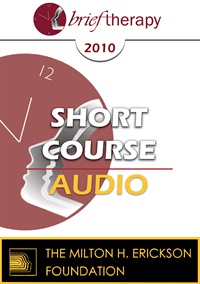
- Average Rating:
- Not yet rated
- Topic Areas:
- Hypnosis | Short Courses | Pain and Healing | Brief Therapy | Self-Hypnosis | Trance
- Categories:
- Brief Therapy Conference | Brief Therapy Conference 2010
- Faculty:
- Deborah Beckman
- Duration:
- 1:23:17
- Format:
- Audio Only
- Original Program Date:
- Dec 09, 2010
- Short Description:
- Clients in pain yearn for sleep; comfort just out of reach. Focus first on establishing soothing sleep and encouraging nocturnal restorative functions. Treating remaining pain stays in the day’s domain. Hypnosis enlists the mind and body’s natural processes, restoring healthy sleep. Strategic protocols combine physiology of sleep and pain management with the client’s own experience. These are further reinforced by self-hypnosis techniques. Program includes demonstration, application of trance script protocols, and case study discussion. With Deborah Beckman.
- Price:
- $15.00 - Base Price

- Average Rating:
- Not yet rated
- Topic Areas:
- Trance | Short Courses | Art and Creativity | Brief Therapy
- Categories:
- Brief Therapy Conference | Brief Therapy Conference 2010
- Faculty:
- Betty Blue, PhD
- Duration:
- 1:08:53
- Format:
- Audio Only
- Original Program Date:
- Dec 09, 2010
- Short Description:
- This workshop will use PowerPoint images, research, theories, examples and experiential exercises to demonstrate how therapeutically playful interaction with others may create lasting solutions by producing spiritually-uplifting catharsis and creatively explorative trance states capable of replacing sensations of helplessness with sensations of empowerment, enhancing sensations of meaningful relatedness, encouraging immune system functioning and possibly serving to “wake up” otherwise dormant genetic functioning and activate brain plasticity. With Betty Blue.
- Price:
- $15.00 - Base Price

- Average Rating:
- Not yet rated
- Topic Areas:
- Trance | Workshops | Mindfulness
- Categories:
- Brief Therapy Conference | Brief Therapy Conference 2010
- Faculty:
- Stephen Gilligan, PhD
- Duration:
- 2:42:26
- Format:
- Audio Only
- Original Program Date:
- Dec 10, 2010
- Short Description:
- BT10 Workshop 32 - Mindfulness and Trance: A Third Generation Approach to Transformational Change - Stephen Gilligan, PhD This workshop presents a third generation approach to the therapeutic use of trance. The first generation was authoritarian, "knocking out" the conscious mind and programming the unconscious mind. The second generation, developed by Milton Erickson, respected the creative unconscious but not the conscious intelligence of the client. This third generation work emphasizes the complementary intelligences of the conscious and creative unconscious minds, and explores how to shift both to a generative level that allows significant transformational change.
- Price:
- $15.00 - Base Price
- Average Rating:
- Not yet rated
- Topic Areas:
- Clinical Demonstrations | Trance | Generative Psychotherapy
- Categories:
- Brief Therapy Conference | Brief Therapy Conference 2012
- Faculty:
- Stephen Gilligan, PhD
- Course Levels:
- Master Degree or Higher in Health-Related Field
- Duration:
- 59:15
- Format:
- Audio and Video
- Original Program Date:
- Dec 07, 2012
- Short Description:
- This demonstration will show how problems/symptoms may be viewed as attempts by the creative unconscious to bring transformation and healing, and how the development of a generative trance can allow that transformation to be realized.
- Price:
-
Sale is $29.00
price reduced from Base Price - $59.00
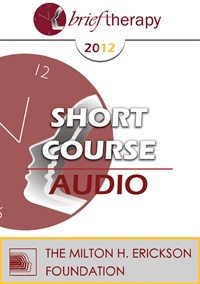
- Average Rating:
- Not yet rated
- Topic Areas:
- Trance | Short Courses
- Categories:
- Brief Therapy Conference | Brief Therapy Conference 2012
- Faculty:
- Betty Blue, PhD
- Duration:
- 1:20:15
- Format:
- Audio Only
- Original Program Date:
- Dec 05, 2012
- Short Description:
- BT12 Short Course 27 – Illuminating Solutions with the Trance-Sending Light of Compassionate Playfulness – Betty Blue, PhD Participants are invited to explore and experience spiritually uplifting, trance-forming, life-affirming, compassionately bonding and solution rehearsing processes and techniques comprising Transcendence-focused Playfulness. Emphasis will be on how such processes may transform learned helplessness into personal empowerment and contribute to emotion-based neurochemical regulation, well-being, immunoenhancement and gene expression. Examples and group participation will highlight “Metaphorplay”, playful paradox, soothing and energizing imagination activation, musical catharsis and reciprocating the compassionate radiance of “natural highs”.
- Price:
- $15.00 - Base Price
Tags: Compassion Trance
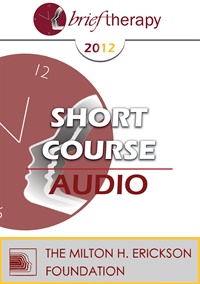
- Average Rating:
- Not yet rated
- Topic Areas:
- Trance | Trauma | Short Courses | Mindfulness | Hypnosis
- Categories:
- Brief Therapy Conference | Brief Therapy Conference 2012
- Faculty:
- Ronald Alexander, PhD
- Duration:
- 1:29:32
- Format:
- Audio Only
- Original Program Date:
- Dec 09, 2012
- Short Description:
- BT12 Short Course 30 – Mindfulness, Trauma, and Trance: Ericksonian Brief Solutions: A Mind/Body Approach – Ronald Alexander, PhD This course will address the rapid treatment of trauma by utilizing both Mindfulness practice and Ericksonian orientation. The course will highlight Milton Erickson’s use of storytelling, metaphor and rapid trance induction as well as the use of mindfulness practice for framing, re-framing and de-framing the immediate reorganization of transforming somatic-affective experience into new healing rhythms in the body. These methods allow the body to open healthier pathways for new somatic recoveries. We will also emphasize the use of naturalistic hypnotic trance, guided mindfulness practice, and healing metaphors for generating new therapeutic skills in mindbody healing therapies.
- Price:
- $15.00 - Base Price
Tags: Mind-Body Mindfulness
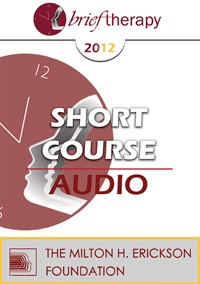
- Average Rating:
- Not yet rated
- Topic Areas:
- Trance | Neuroscience | Psychotherapy | Short Courses
- Categories:
- Brief Therapy Conference | Brief Therapy Conference 2012
- Faculty:
- Susan Pinco, PhD
- Duration:
- 1:13:42
- Format:
- Audio Only
- Original Program Date:
- Dec 09, 2012
- Short Description:
- BT12 Short Course 47 – Is it the Talking that Cures? An Exploration of the Role of Silence and Words in the Clinical Encounter – Susan Pinco, PhD Explore the role that silence plays in the hypnotic and clinical process. Our journey will begin with a discussion of structured and unstructured silence, how both are manifested, and potentially utilized. It continues with an overview of research related to silence in psychotherapy as well as findings in neuroscience that help explain why silence is a key ingredient in effective trance-formational processes. Attendees will engage in exercises that are designed to expand their awareness of the pivotal role that silence plays in healing and in so doing facilitate the conscious development of strategic interventions that utilize silence hypnotically to address a wide range of clinical issues.
- Price:
- $15.00 - Base Price
Tags: Neuroscience Psychotherapy Trance
- Average Rating:
- Not yet rated
- Topic Areas:
- Clinical Demonstrations | Psychotherapy | Generative Psychotherapy | Art and Creativity | Brief Therapy | Trance
- Categories:
- Brief Therapy Conference | Brief Therapy Conference 2014
- Faculty:
- Stephen Gilligan, PhD
- Course Levels:
- Master Degree or Higher in Health-Related Field
- Duration:
- 59:41
- Format:
- Audio and Video
- Original Program Date:
- Dec 13, 2014
- Short Description:
- This demonstration will show how problems/symptoms may be viewed as attempts by the creative unconscious to bring transformation and healing, and how the development of a generative trance can allow that transformation to be realized.
- Price:
-
Sale is $29.00
price reduced from Base Price - $59.00
- Average Rating:
- Not yet rated
- Topic Areas:
- Hypnosis | Short Courses | Brief Therapy | Trance
- Categories:
- Brief Therapy Conference | Brief Therapy Conference 2016
- Faculty:
- Robert McNeilly, MBBS
- Course Levels:
- Master Degree or Higher in Health-Related Field
- Duration:
- 1:29:10
- Format:
- Audio and Video
- Original Program Date:
- Dec 08, 2016
- Short Description:
- Drawing on Erickson's idea of the common everyday trance, we will find an easy and respectful method of inviting anyone into hypnosis. Because hypnosis creates an experience, we can explore ways of assisting any individual to move beyond the possibility of a preferred outcome that brief therapy is so helpful for and allowing them to create a direct and bodily felt experience of that desired outcome.
- Price:
-
Sale is $29.00
price reduced from Base Price - $59.00
Tags: Brief Therapy Hypnosis Trance
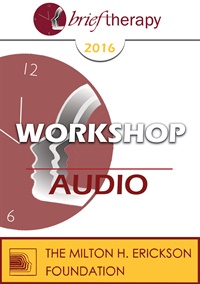
- Average Rating:
- Not yet rated
- Topic Areas:
- Couples Therapy | Trance | Workshops | Hypnotic Induction | Brief Therapy | Psychobiological Approach to Couples Therapy (PACT) | Attachment | Therapeutic Process
- Categories:
- Brief Therapy Conference | Brief Therapy Conference 2016 | Pioneers in Couples and Family Therapy
- Faculty:
- Stan Tatkin, PsyD, MFT
- Duration:
- 3:11:14
- Format:
- Audio Only
- Original Program Date:
- Dec 11, 2016
- Short Description:
- This workshop (the first of two) introduces the use of informal trance and rolling chairs in couple therapy to support arousal regulation and deeper relational work. Drawing from the Psychobiological Approach to Couple Therapy (PACT), the session demonstrates how proximity, eye contact, and movement can elicit trance states, enabling therapists to access implicit issues. Techniques like the crossing and “down the middle” methods help clarify dynamics and promote secure functioning. Attendees learn to manage emotional states, reduce stress loads, and guide partners toward more resilient connection.
- Price:
- $15.00 - Base Price
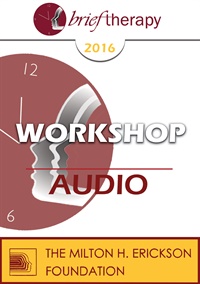
- Average Rating:
- Not yet rated
- Topic Areas:
- Workshops | Couples Therapy | Hypnotic Induction | Trance | Psychobiological Approach to Couples Therapy (PACT) | Brief Therapy | Attachment | Communication | Experiential Therapy
- Categories:
- Brief Therapy Conference | Brief Therapy Conference 2016 | Pioneers in Couples and Family Therapy
- Faculty:
- Stan Tatkin, PsyD, MFT
- Duration:
- 2:58:09
- Format:
- Audio Only
- Original Program Date:
- Dec 11, 2016
- Short Description:
- This workshop (the second of two) introduces the use of informal trance and rolling chairs in couple therapy to support arousal regulation and deeper relational work. It also showcases body-based techniques like the "Lovers Pose" and "King and Queen" exercises. Drawing from the Psychobiological Approach to Couple Therapy (PACT), it demonstrates how stationary positioning, eye contact, and right-brain engagement access implicit memory and deepen emotional connection. Through live and video demonstrations, participants learn to manage arousal, shift power dynamics, and guide couples toward secure attachment and healing.
- Price:
- $15.00 - Base Price
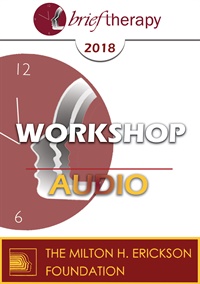
- Average Rating:
- Not yet rated
- Topic Areas:
- Workshops | Couples Therapy | Hypnosis | Trance | Family Therapy | Brief Therapy | Resources | Resistance
- Categories:
- Brief Therapy Conference | Brief Therapy Conference 2018
- Faculty:
- Camillo Loriedo, MD, PhD
- Duration:
- 1:58:55
- Format:
- Audio Only
- Original Program Date:
- Dec 07, 2018
- Short Description:
- Hypnosis will be presented within a system perspective, as a circular and evolving process, while couples and families will be considered as a source of natural healing resources that the therapist should discover and activate. Specific direct and indirect techniques required to induce a deep and meaningful change of the most rigid family patterns will be introduced. The demonstration of a family hypnotic session will give a clear idea of the powerful and subtle resistances families can develop in the course of the hypnotic treatment as well as of how naturalistic systemic hypnosis can transform these resistances in the required solutions.
- Price:
- $15.00 - Base Price
- Average Rating:
- Not yet rated
- Topic Areas:
- Clinical Demonstrations | Hypnosis | Psychotherapy | Trance
- Categories:
- Evolution of Psychotherapy | Evolution of Psychotherapy 2009
- Faculty:
- Ernest Rossi, PhD
- Course Levels:
- Master Degree or Higher in Health-Related Field
- Duration:
- 57:38
- Format:
- Audio and Video
- Original Program Date:
- Dec 11, 2009
- Short Description:
- Educational Objectives: To describe the general waking trance in brief psychotherapy. To describe the four-stage creative cycle in brief psychotherapy.
- Price:
-
Sale is $29.00
price reduced from Base Price - $59.00
Tags: Hypnosis Psychotherapy Trance
- Average Rating:
- Not yet rated
- Topic Areas:
- Clinical Demonstrations | Trance | Generative Psychotherapy | Psychotherapy
- Categories:
- Evolution of Psychotherapy | Evolution of Psychotherapy 2009
- Faculty:
- Stephen Gilligan, PhD
- Course Levels:
- Master Degree or Higher in Health-Related Field
- Duration:
- 53:41
- Format:
- Audio and Video
- Original Program Date:
- Dec 11, 2009
- Short Description:
- Educational Objectives: To describe how symptoms can become solutions under conditions of generative trance. To describe how a generative trance unfolds from the client’s unique processes and idiosyncratic values.
- Price:
-
Sale is $29.00
price reduced from Base Price - $59.00
EP13 Clinical Demonstration 07 – Generative Trance and Transformation (Live) – Stephen Gilligan, PhD
- Average Rating:
- Not yet rated
- Topic Areas:
- Clinical Demonstrations | Trance | Generative Psychotherapy | Psychotherapy
- Categories:
- Evolution of Psychotherapy | Evolution of Psychotherapy 2013
- Faculty:
- Stephen Gilligan, PhD
- Course Levels:
- Master Degree or Higher in Health-Related Field
- Duration:
- 51:22
- Format:
- Audio and Video
- Original Program Date:
- Dec 13, 2013
- Short Description:
- This demonstration will show how problems/symptoms may be viewed as attempts by the creative unconscious to bring transformation and healing, and how the development of a generative trance can allow that transformation to be realized.
- Price:
-
Sale is $29.00
price reduced from Base Price - $59.00
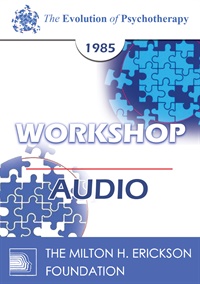
- Average Rating:
- Not yet rated
- Topic Areas:
- Workshops | Hypnosis | Hypnotic Phenomena | Trance
- Categories:
- Evolution of Psychotherapy | Evolution of Psychotherapy 1985
- Faculty:
- Ernest Rossi, PhD
- Duration:
- 2:23:27
- Format:
- Audio Only
- Original Program Date:
- Dec 15, 1985
- Short Description:
- All audience members will have an opportunity to assess their own readiness to resolve a basic personal issue via the accessing experience of deep trance phenomena.
- Price:
- $15.00 - Base Price


